|
|
 |
|
|
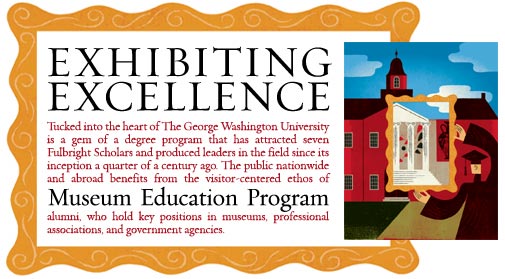

These decision- and policy-makers, constituting an influential cadre devoted to civic and cultural service, found their voice and honed their competence during the intensive yearlong pursuit of their master of arts in teaching in museum education.
In the midst of a campus perhaps best known for focusing on law, medicine, and international affairs, the MEP’s success rests on its students’ personal commitment to preparing, for the most part at considerable financial sacrifice, for a demanding profession without the promise of compensation commensurate with their investment. This sense of dedication underlies the extraordinary loyalty manifested by alumni who regularly refer prospective applicants and repeatedly donate monetary support to the MEP. Moreover, they recognize themselves as a cohesive force in the universe of learning, with a shared mission of advocating for accessibility and accountability. After their year at GW, their identification with the MEP runs deep; alumni from different decades—say, the classes of ’78, ’85, and ’01—feel comfortable seeking advice from or alliance with each other, regardless of distant geographic locations or disparate institutional affiliations—whether it be art, history, or science; a children’s museum, botanic garden, or university archives; in a sector that is private, government, or consultant.
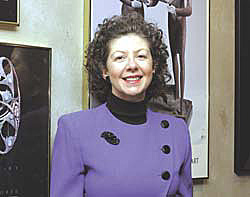
Kim Igoe, MAT ’76, vice president for policy and programs at the American Association of Museums
Claire Duggan
|
Furthermore, many of the 500-plus alumni choose to maintain close contact with the MEP, turning back on occasion for wisdom and guidance. Following in the footsteps of MEP founder and Professor Emeritus Marcella Brenner, who retired in 1983, the current director embraces opportunities for relationships with former students. Part of the faculty since 1977, Carol B. Stapp has become the face of the MEP. Renowned as a champion of excellence and equity in the museum world, she cites her years on the “front lines” at the Philadelphia Museum of Art, in addition to her mix of academic degrees—a bachelor’s and master’s in art history, followed by a doctorate from GW in American studies with an emphasis on material culture—and study abroad (in Paris and in India), as her defining credentials. In the final analysis, Stapp considers herself primarily a mentor, striving to encourage in MEP students and alumni (some of whom are profiled here) a love for learning and teaching comparable to the tenets instilled in her by her parents (see below).
Not surprisingly, MEP alumni have ascended to the top rungs of the museum world. Pivotal among them is Kim Igoe, MAT ’76, vice president for policy and programs at the American Association of Museums in Washington. “Over the past 20 years at the AAM, I’ve often felt as if I run the largest museum education program in the country,” declares Igoe, whose mandate stresses making museums more viable, sustainable operations to serve the public better. “Museums are essential to the lives of their communities and have a civic role far beyond that of cultural symbol, caretaker of collections, economic engine, and provider of educational opportunities. The AAM provides support and assistance to museums on a number of initiatives, such as exploring how museums can become even more vital community resources and partners.” This past year, Igoe helped coordinate museum efforts across the country to mark the first anniversary of the tragic events of Sept. 11. “There was a great deal of interest within the museum community to celebrate America’s freedom and remember the events of Sept. 11 with their communities,” she explains. “Many museums worked with their communities to take a leadership role in figuring out how best to observe 9/11.”
“Museums are essential to the lives of their communities and have a civic role far beyond that of cultural symbol, caretaker of collections, economic engine, and provider of educational opportunities.” — Kim Igoe, MAT ’76
|
Typically, Igoe says that she landed in the museum trade by happenstance. “I was on my way to library science school when I became beguiled by museums after taking a part-time job putting together traveling exhibit programs,” she remembers. “The MEP was a wonderful gateway into my career.” Since entering museum life, Igoe has not looked back. “Museums and libraries are such content-rich organizations,” she notes. “I’ve always felt that they are underutilized as educational resources, not only for the K-12 group, but for pre-K through lifelong learners. There’s nothing more rewarding than helping to build the institutional capacity of museums so that they can better serve the public as intellectual and educational community resources. It’s no small goal, but it’s fun connecting all the dots.”
Like Igoe, Schroeder Cherry, MAT ’78, enjoys a bird’s-eye view of the museum world. As deputy director for museums at the Institute of Museum and Library Services, he oversees the distribution of grants to museums by the federally funded agency. “I have the good fortune to know about museum offerings across the country and to help facilitate opportunities that are important to the field,” he remarks. “We respond to the full spectrum of museums—aquariums, arboretums, historic houses, art museums, children’s museums, science centers, and others, distributing grants ranging from $5,000 to $500,000 for up to three years. It’s particularly gratifying to work with people who are likeminded in their passion for museums as important organizations in contemporary society and interested in promoting them to the broader public.”
Cherry brings a wealth of experience to his position. Since graduating from GW’s MEP, he has worked at seven museums around the country, including the Baltimore Museum of Art, the J. Paul Getty Museum in Los Angeles, and the Studio Museum in Harlem, New York City. “My career has been described as peripatetic,” he acknowledges, “but the unifying theme throughout has been an emphasis on meaningful programs that draw audiences. It’s been exhilarating to see firsthand the important role that museums play in lifelong learning.”
Many other MEP alumni are similarly making their mark worldwide by translating their broad-based understanding of museums into enjoyable and significant experiences for a varied constituency. Take the case of Elizabeth “Liz” Maurer, MAT ’01, manager of education projects at George Washington’s Mount Vernon Estate and Gardens. Responsible for conducting research for a future 20,000-square-foot education center on the grounds of the presidential estate, Maurer describes the facility of 15 galleries and three theaters, targeted for opening in 2008, as state of the art. “This will be the most comprehensive set of exhibits about George Washington, examining every aspect of his life from birth to death,” she predicts. “People who visit will have an immersive experience and will therefore walk away comprehending more about our nation’s first president.”
The job is a perfect fit for Maurer, a long-time fan of history museums. “I’ve been a biography buff since middle school, which led me naturally to visiting historic homes of famous people,” she relates. “I decided to make history museums my career focus because I see them as a great way to take people out of their everyday lives to a completely different time and place. When museums are done well, they transport visitors not just physically, but also mentally and emotionally.”
Maurer especially treasures applying her energies on behalf of one prominent person. “For me, history always starts with an individual,” she says. “It’s so rewarding to see the public develop relationships with or emotional connections to a historical figure after coming to the museum. If visitors leave feeling as if they really know the famous person who lived here, or as if they’ve actually visited another time and place, we know that we have succeeded.”
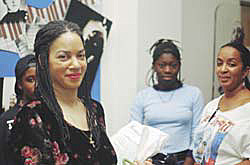
Marta Reid Stewart, MAT ’87, director of the museum studies department at the Duke Ellington School of the Arts in Washington
Claire Duggan
|
For the past 10 years, Marta Reid Stewart, MAT ’87, has directed the museum studies department at the Duke Ellington School of the Arts in Washington. The only public high school museum studies program in the country, this magnet school has graduated some 100 museum studies students in the last decade. “When I came to Duke Ellington in March 1992, museum studies was just an idea,” recalls Stewart, “and I was hired to make the program real. We developed a course of study aimed at giving students experiences in museography and museology, as well as a firm knowledge base in art, history, and science—subject areas most affiliated with museums. We try to instill in our students a love of learning and an appreciation for the many contributions that museums make to the world.”
A lifelong art and museum lover, Stewart indicates that the job allows her to put her GW museum education background and knowledge to use on a daily basis. “I believe it was writer James Weldon Johnson who said that a society or culture is judged by the art it leaves behind,” observes Stewart. “With that as a backdrop, the importance of museum studies rests on our ability to train a new generation of decision makers who will be responsible for collecting, preserving, displaying, and interpreting that art. We are doing something very special and necessary here, and it’s extremely rewarding.”
Elementary school-aged children across New York City are benefiting from a groundbreaking outreach program administered by Rebecca Shulman Herz, MAT ’97, at Manhattan’s famed Guggenheim Museum. Herz manages the Guggenheim’s Learning through Art program, which enhances young people’s familiarity with the arts by placing seasoned teaching artists in their classrooms for yearlong residencies. Last year, for example, fourth-grade students examined artist Marc Chagall’s work and life as an immigrant. With Chagall’s painting, “The Green Violinist,” for inspiration, the participants wrote and performed an original play, using paper mache and fabric to create puppets of the characters. Every spring, the museum showcases the students’ artwork in a special exhibition, “A Year with Children,” curated by Herz.
“It’s marvelous to teach using a Picasso or a Chagall,” points out Herz, who has been on the staff at the Guggenheim for the past four years. “My passion is school programs, so I’m lucky to be doing what I love. It’s our hope that the kids are not only having a great time learning about art and art techniques, but that they are also using art to master school subject matter and that they will take it a step further, creating something new.”
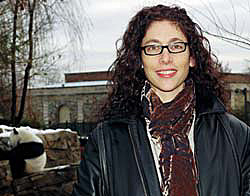
Susan Ades, MAT ’89, exhibit developer at the National Zoological Park
Claire Duggan
|
As in the art world, Mother Nature proffers myriad possibilities for MEP alumni to exercise their repertory of skills and knowledge. Animal lover and museum enthusiast Susan Ades, MAT ’89, recognized her vocation as an exhibit developer at the National Zoological Park in Washington. “Like a lot of people who go into museum education, I wound up in the field as a result of happy circumstance,” she comments. “I was working at a contemporary art center in Washington, where I fell into serving as the center educator in charge of school groups. I realized that I needed some formal training to convey complex ideas to audiences and to make meaningful connections between audiences and museums. GW’s MEP was a perfect fit, giving me the theoretical background that I was lacking, as well as an excellent grounding in the practice of museum education.”
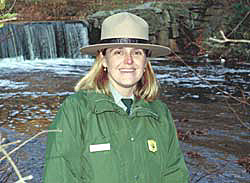
Anne O’Neill, MAT ’01, park ranger at the Rock Creek Park Nature Center
Claire Duggan
|
Since graduating, Ades has concentrated on exhibit development, first with the Smithsonian Institution Traveling Exhibition Service, and, for the past five years, at the National Zoo. “I feel that exhibits are the aspect of a museum with which people interact the most,” she asserts. At the zoo, Ades coordinates teams composed of exhibition developers, 3-D designers, graphic designers, writers, photo researchers, content researchers, and media specialists. “We design both the habitats for the animals and the interpretive signage and exhibits for the visitors,” she notes. A major highlight for Ades was helping to design the National Zoo’s much-heralded new panda compound and exhibit in 2000, welcoming the arrival of Tian Tian and Mei Xiang from China. “In April, we found out that we’d be getting the pandas. And between then and their arrival in December, it was all hands on deck,” she recounts. “In record time, we renovated the panda house, developed a graphic identity package for the pandas, and designed and built the panda yard. It’s a process that would ordinarily take three to five years, and we did it in six to eight months.”
Anne O’ Neill, MAT ’01, too, spends much of her professional life communing with nature, through her job as a park ranger at the Rock Creek Park Nature Center. “I’d been working for the National Park Service for a few years and had hit a plateau, when one of my colleagues advised me to check out GW’s Museum Education Program,” she recollects. “It was ideal, because it really looks at the big picture of education in the museum world and offers hands-on experiences with different audiences.”
“[GW’s Museum Education Program] was ideal, because it really looks at the big picture of education in the museum world.”
—Anne O’Neill, MAT ’01
|
Degree in hand, O’Neill has soared professionally, recently winning the Freeman Tilden Award for the National Capital Region of the National Park Service for her outreach work to Washington, D.C.’s Latin American community. “When I received the award, I made a speech thanking the Museum Education Program for opening my mind and allowing me to go to that next level,” O’Neill says. “My job is so multifaceted that it’s always engaging,” she adds. “The best part is working with the public—whether through doing Latin American outreach, partnering with a school group, or just seeing the enthusiasm in people’s eyes. That’s what keeps you going—when a visitor makes that connection—planting the seeds for a new generation.”
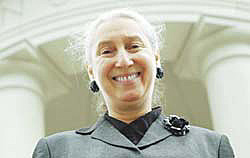
MEP Director Carol B. Stapp
Claire Duggan
|
Stapp shares those sentiments, receiving immense satisfaction from watching her students grow into alumni who assume leadership positions in the museum education field. “MEP faculty invest an incredible number of hours, but receive an astounding return in terms of loyalty, generosity, and closeness with our students and alumni,” she stipulates. Stapp accords degree candidates the respect and responsibility inherent in the MEP motto, “The learner controls the learning,” while the graduates command her admiration for their manifold accomplishments. “I’m so appreciative of the privilege of getting to know our students well during their time in the sequence of intensive core courses at GW and then being able to share in their success as they go on to make a difference in the museum world.”
A special thanks to MEP Director Carol Stapp and Associate Editor Jamie L. Freedman for their assistance with this article.
MEP Facts and Faces
One of the premier museum training programs in the country, GW’s Museum Education Program was founded by Professor Emeritus Marcella Brenner, EdD ’62, in 1973 as the country’ first professional course of study for museum educators. The four-semester, 33-credit interdisciplinary program combines academic study with hands-on fieldwork at top museums and educational sites, leading to the degree of Master of Arts in Teaching in Museum Education. As of July, 29 classes comprised of more than 500 students had completed the core courses. Approximately three-quarters of alumni now hold museum-related positions across the country and around the world, creating a strong GW network in the profession.
Many of the MEP’s graduates have risen through the ranks to become museum directors at sites like Plimouth Plantation in Massachusetts and Fort Concho National Historic Landmark in Texas. Others are traveling a parallel route as staff members of government agencies like the Wisconsin Humanities Council and the U.S. Department of Education. Either way, the vast majority of alumni carry out the multiple functions of the museum educator, regardless of their specific title, which might be “curator of education,” “docent coordinator,” or “deputy director for interpretation.” In their work, alumni may contribute to the development of exhibits, design programming or participatory activities for families, write interpretive materials, conduct audience research, and arrange film series. They also reach far beyond the museum’s walls, designing and distributing resource materials, preparing traveling kits and exhibitions, building Web sites, and partnering with schools.
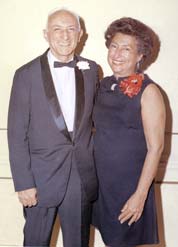
Last year, an MEP endowment was named in honor of Doris and Sam Buchalter, for their regard for lifelong learning.
Claire Duggan
|
A sense of mutual understanding and common objective unites the alumni, springing from their transforming time at GW. “There’s genuine bonding among our students because they move through the sequence of intensive core courses as a cohort,” notes Carol B. Stapp, MEP director since 1983. “We tell them right from the start that it’s a matter of collaboration, not competition.” This non-adversarial tone permeates MEP principles and practices. All semesters incorporate the three quite current yet highly traditional charges of the museum educator, known in MEP-speak as the “Three A’s”: accessibility, accountability, and advocacy.
MEP curriculum, predicated upon access to the D.C.-metropolitan area’s dynamic museum community, melds the academic with the pragmatic and theory with application. “Each of the core courses interweaves classroom instruction with field experiences, the professional literature with actual practice, and highly-structured assignments with individual creativity,” elaborates Stapp. Clearly, the MEP’s Washington, D.C., location is as integral to its routine functioning as it is to its raison d’etre. Each year, innumerable museum professionals willingly volunteer their time, enthusiasm, and expertise. They introduce an invaluable dimension to the students’ intellectual and social maturation, whether appearing in the guise of guest speaker, workshop leader, internship supervisor, or institutional liaison.
This ongoing synergy of the MEP with the Washington museum community is mirrored by a delicate but durable web of financial support that friends and followers have generated to sustain MEP endeavors. An exceptional caliber of magnanimity has inspired three sources of funds, all with meaningful origins. First, the Marcella Brenner Endowment for Museum Education was established in 1983 by Gloria L. Horrworth, a GW colleague and professor emeritus, to honor the work and spirit of the MEP founder upon her retirement. Horrworth’s tribute to Brenner garnered a chorus of hoorays, and the Brenner Endowment has grown steadily over the years through a multiplicity of gifts, large and small, from an ever-growing roster of repeat donors.
Second, the Rossetta A. and Sadie B. Feldman Fellowships in Museum Education were initiated in 1996-97, intended to commemorate through bequest the “wonderful period” that she and her sister spent at GW (both are MA ’40). Delighted to advance her dual interests in education and museums, Baltimore native Sadie Feldman has designated MEP students as the beneficiaries of her fond memories of GW, in conjunction with her keen remembrance of days happily teaching art in a D.C. junior high school and years avidly visiting museums in Washington.
Third, in February 2002, the Doris and Sam Buchalter Endowment for Museum Education was launched by the six Buchalter siblings (of which Carol Stapp is one) to reflect the honorees’ high regard for learning and deep respect for teaching. Given her parents’ profound belief in broadening horizons for everyone, Stapp linked her parents’ history and character to the principles of lifelong learning and accessible teaching to which the MEP subscribes. As noted by the well regarded museum educator reference, The American Association of Museums’ Excellence and Equity: Education and the Public Dimension of Museums those principles are embodied by the idea that the museum is envisioned as the ideal venue, “to nurture an enlightened, humane citizenry.”
|
|